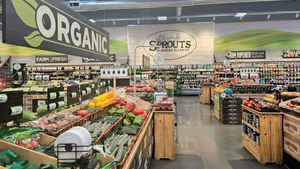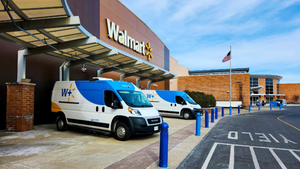Whole Foods Market to consolidate some operationsWhole Foods Market to consolidate some operations
Specialty grocer outlines changes and growth plans in company memo
May 14, 2021

In a letter to employees, Whole Foods Market took stock of its growth but announced plans to streamline some operations, including merchandising, store operations, technology and human resources.
Amazon-owned Whole Foods said yesterday it will merge global and regional merchandising into one team that will support companywide purchasing. The Austin, Texas-based specialty grocer also is forming regional operations teams dedicated to merchandising execution and in-store operations, including e-commerce and store support, and creating new leadership roles for local products and supplier relationships.
Whole Foods said the changes will improve the customer and employee experience by enabling regional operations to focus on running our stores and better defining team members’ roles, growth opportunities and paths for advancement in operations and merchandising. The move also is expected to help the retailer bolster its assortment natural and organic products, including an improved selection of local offerings, exclusive and emerging brands, and innovative items.
In technology, Whole Foods said it will shift the organization’s focus more toward software engineering and technical product and program manager roles. The transition is expected to help the company build new internal capabilities, differentiate its retail offerings, and speed the development of business and customer tools.

In September, Whole Foods opened a 'dark store' in Brooklyn's Industry City section that only fills online grocery orders.
Meanwhile, the Team Member Services organization will be realigned to reinforce support across the chain’s regions in areas such as recruiting, training, compensation and benefits, and career development. That includes greater use of the Workday HR platform to better support employee growth and meet business objectives.
In the memo and an accompanying statement, posted on its corporate website, Whole Foods didn’t announce layoffs or specify the impact to employees in the affected areas. However, the company noted there would be no impact to the workforce at the store level.
“To continue meeting the evolving needs of our customers and sustain our growth, we are making changes to a few of our regional and global support teams: merchandising and operations, Team Member Services and technology. Evolving the structure and increasing the capabilities of these teams will enable us to enhance the customer experience and more effectively support our stores, team members and supplier partners. Ultimately, this will ensure we continue delivering on our purpose to nourish people and the planet,” Whole Foods said in the May 13 letter.
“These changes will not impact any store or distribution center-based roles. All changes are limited in scope to global and regional office roles,” the company said in its statement with the letter. “These changes are designed to improve support for our stores and distribution centers as we remain committed to delivering an exceptional customer experience in stores and online.”
Whole Foods also said it will be “making some changes” to its Allegro Coffee organization but provided no further details. The retailer acquired the Allegro Coffee Co. in late 1997 and made it an exclusive brand and signature offering at its in-store cafés. Published reports have said Whole Foods is swapping out the Allegro café space at some locations to accommodate its growing online grocery pickup and delivery operations.

Whole Foods expanded curbside pickup in 2020 to provide contactless fulfillment for online orders during the pandemic.
The planned changes at Whole Foods come after Seattle-based parent Amazon reported a continued decline in physical store sales for the 2021 first quarter, despite booming online and overall sales. Amazon’s brick-and-mortar sales — driven mainly by Whole Foods’ more than 500 stores — fell 15.5% to $3.92 billion in the first quarter, marking a 2.5% quarterly sequential decrease and following an 8% year-over-year drop in the 2020 fourth quarter. In fiscal 2020, Amazon recorded physical-store sales declines in three out of four quarters. The company doesn’t break out financial results among its physical stores.
Still, Whole Foods noted its growth on various fronts, including across delivery, pickup and in-store channels. The retailer said it created more than 10,000 new jobs last year and now aims to fill roughly another 10,000 open positions companywide. Online sales tripled between March and December 2020 versus the prior-year period, Whole Food reported.
On the brick-and-mortar side, Whole Foods opened 18 stores in 2020 and said it has nearly 40 more new locations in the pipeline. Last year’s openings allowed the chain to reach about 1.4 million more people within a 10-mile radius of its U.S. stores, the company said.
“Over the past several years, Whole Foods Market has reached several significant growth milestones,” Whole Foods said in the employee letter. “We’ve surpassed 500 stores, exceeded more than 105,000 team members, and introduced new ways for our customers to shop by launching pickup and delivery. No words can convey how proud we are of our team, and it’s your dedication that made these achievements possible.”
Also in 2020, Whole Foods launched and expanded new concepts, including its first online-only store in Brooklyn, N.Y., in September and the Ideal Market in Denver in October. Last year also saw Whole Foods introduce more than 950 local brands, over 10,000 local items and more than 650 exclusive brands.
“We are confident these changes will position us to better support our stores and serve our customers as we continue to grow,” Whole Foods said in the letter’s closing. “We have many reasons to be optimistic about what’s ahead as we emerge from the pandemic. We look forward to welcoming our customers back to our stores, reinvigorating our prepared foods operations, having more face-to-face interactions among team members, and delivering that exceptional experience that can only be found at Whole Foods Market. Looking to the rest of 2021 and beyond, we are excited to continue serving more communities, leading the way in shaping the future of grocery retail, and advancing our mission to nourish people and the planet for many years to come.”
Overall, Whole Foods currently operates 526 stores across 12 regions, including 505 locations in the United States, 14 in Canada and seven in the United Kingdom.
Read more about:
AmazonAbout the Author
You May Also Like


.webp?width=300&auto=webp&quality=80&disable=upscale)



